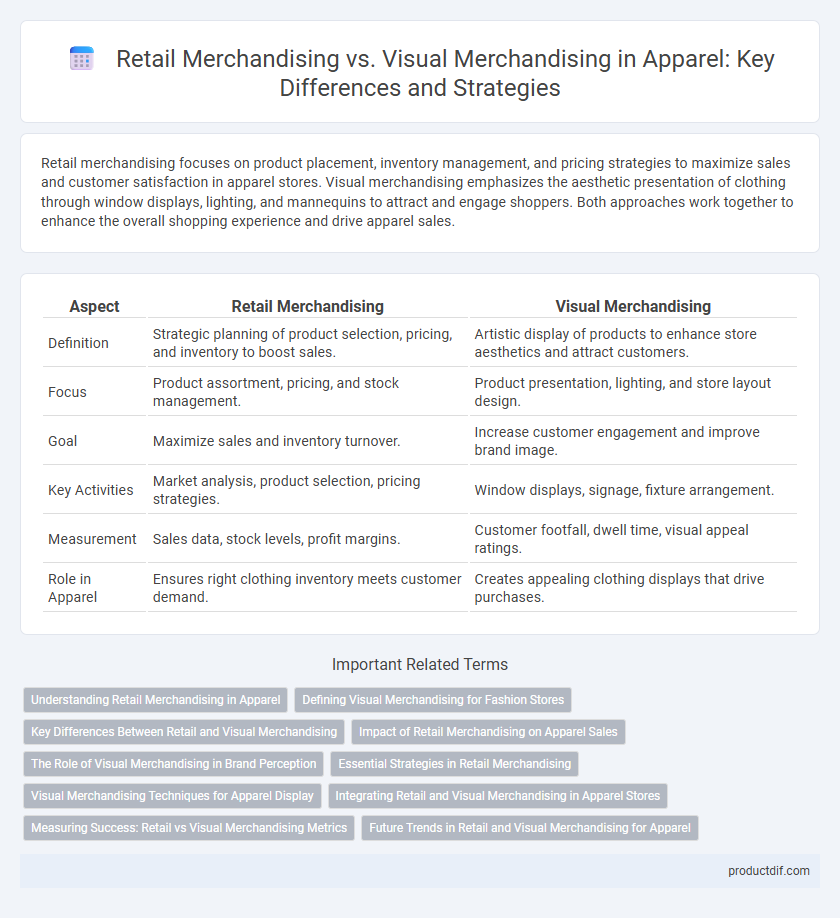Retail merchandising focuses on product placement, inventory management, and pricing strategies to maximize sales and customer satisfaction in apparel stores. Visual merchandising emphasizes the aesthetic presentation of clothing through window displays, lighting, and mannequins to attract and engage shoppers. Both approaches work together to enhance the overall shopping experience and drive apparel sales.
Table of Comparison
| Aspect | Retail Merchandising | Visual Merchandising |
|---|---|---|
| Definition | Strategic planning of product selection, pricing, and inventory to boost sales. | Artistic display of products to enhance store aesthetics and attract customers. |
| Focus | Product assortment, pricing, and stock management. | Product presentation, lighting, and store layout design. |
| Goal | Maximize sales and inventory turnover. | Increase customer engagement and improve brand image. |
| Key Activities | Market analysis, product selection, pricing strategies. | Window displays, signage, fixture arrangement. |
| Measurement | Sales data, stock levels, profit margins. | Customer footfall, dwell time, visual appeal ratings. |
| Role in Apparel | Ensures right clothing inventory meets customer demand. | Creates appealing clothing displays that drive purchases. |
Understanding Retail Merchandising in Apparel
Retail merchandising in apparel focuses on product assortment, pricing strategies, and inventory management to maximize sales and profitability. It involves analyzing customer preferences, market trends, and sales data to strategically stock and display clothing items that meet target consumer demands. Effective retail merchandising ensures the right apparel products are available at the right time and price, driving customer satisfaction and repeat business.
Defining Visual Merchandising for Fashion Stores
Visual merchandising in fashion stores involves strategically designing product displays and store layouts to enhance the shopping experience and capture customer attention. It focuses on the aesthetic presentation of apparel through color coordination, lighting, and thematic arrangements to highlight seasonal trends and brand identity. Unlike retail merchandising, which emphasizes inventory management and product assortment, visual merchandising aims to create an immersive and appealing atmosphere that drives sales and brand loyalty.
Key Differences Between Retail and Visual Merchandising
Retail merchandising focuses on product assortment, pricing strategies, and inventory management to maximize sales and profitability, while visual merchandising emphasizes store layout, display design, and aesthetic appeal to enhance customer experience and brand identity. Retail merchandising uses sales data and market trends to optimize stock levels and promotions, whereas visual merchandising leverages color schemes, lighting, and signage to attract and engage shoppers. Both disciplines aim to drive revenue but approach it through operational efficiency versus sensory engagement.
Impact of Retail Merchandising on Apparel Sales
Retail merchandising in apparel directly influences sales by strategically positioning products, managing inventory levels, and optimizing pricing to meet consumer demand. Effective retail merchandising enhances customer experience through targeted product assortments, leading to increased purchase frequency and higher average transaction values. This approach drives brand loyalty and boosts overall revenue by aligning merchandise presentation with shopper preferences and market trends.
The Role of Visual Merchandising in Brand Perception
Visual merchandising plays a crucial role in shaping brand perception by creating immersive and appealing store environments that communicate the brand's identity and values. It strategically utilizes color schemes, lighting, layouts, and product displays to evoke emotional responses and attract target customers, enhancing customer engagement and driving sales. Effective visual merchandising differentiates the brand in competitive apparel markets, reinforcing brand loyalty and influencing purchasing decisions.
Essential Strategies in Retail Merchandising
Essential strategies in retail merchandising include inventory management, product placement, and pricing optimization to maximize sales and profitability. Retail merchandising focuses on analyzing consumer behavior and trends to ensure the right products are available at the right time in-store or online. Effective retail merchandising also involves promotional planning and data-driven assortment decisions to enhance customer engagement and drive purchase frequency.
Visual Merchandising Techniques for Apparel Display
Visual merchandising techniques for apparel display enhance customer engagement through strategic use of color coordination, lighting, and mannequins to highlight key clothing features and create attractive focal points. Incorporating thematic displays and interactive elements boosts brand storytelling and encourages longer store visits. Effective visual merchandising increases product visibility and drives impulse purchases by appealing directly to consumer emotions and aesthetic preferences.
Integrating Retail and Visual Merchandising in Apparel Stores
Integrating retail merchandising and visual merchandising in apparel stores enhances customer experience by aligning product placement with aesthetic displays that highlight key fashion trends and seasonal collections. Effective collaboration ensures inventory is showcased strategically, increasing sales through targeted promotions and cohesive brand storytelling. Leveraging data analytics to synchronize inventory levels with creative visual layouts maximizes foot traffic and boosts overall store performance.
Measuring Success: Retail vs Visual Merchandising Metrics
Retail merchandising success is measured through sales performance indicators such as inventory turnover, average transaction value, and conversion rates, which directly impact profitability. Visual merchandising metrics focus on customer engagement factors like dwell time, foot traffic patterns, and the effectiveness of product displays in driving impulse purchases. Combining these metrics provides a holistic view for optimizing both product availability and in-store experience in the apparel sector.
Future Trends in Retail and Visual Merchandising for Apparel
Future trends in retail merchandising for apparel emphasize data-driven inventory management, personalized customer experiences, and omnichannel integration to meet evolving consumer demands. Visual merchandising will increasingly leverage augmented reality (AR) and AI-powered displays to create immersive, interactive shopping environments that enhance brand engagement. Sustainability and inclusive design principles are becoming central to both retail and visual merchandising strategies, driving innovation in product presentation and ethical consumerism.
Retail merchandising vs Visual merchandising Infographic

 productdif.com
productdif.com